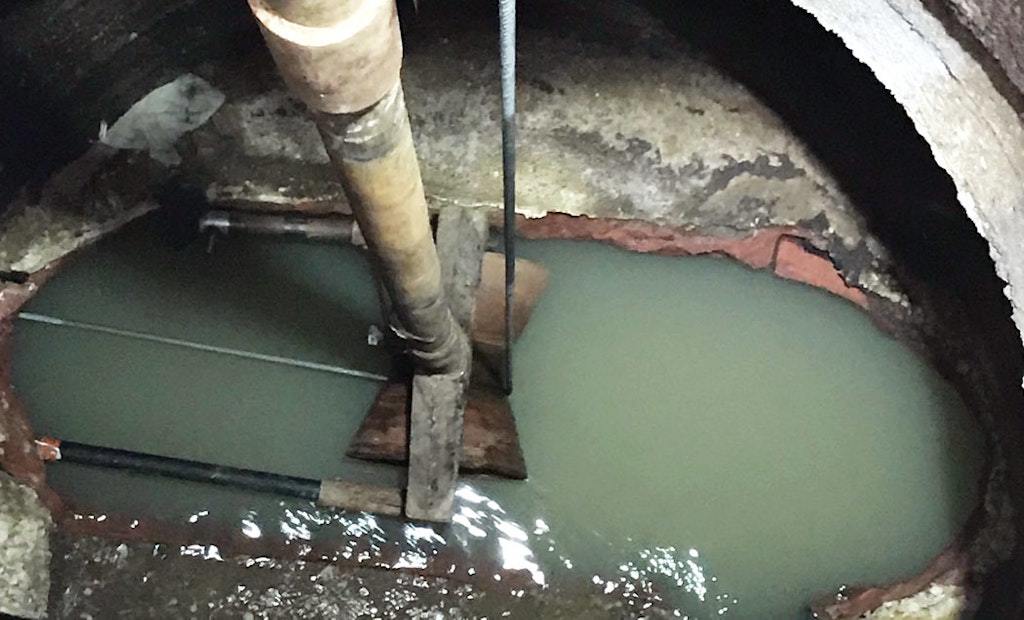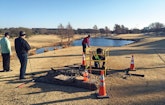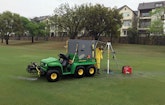
The speed of the Jigawon’s passage through the sewer line is controlled by a winch at the upstream end of the run.
Interested in Cleaning?
Get Cleaning articles, news and videos right in your inbox! Sign up now.
Cleaning + Get AlertsNo vehicles, no heavy equipment, yet the job was cleaning 10,000 feet of 27- to 30-inch sewer main.
The site was the Four Seasons Golf Course in Irving, Texas, and the job would take thousands of feet of hose using conventional methods like a combo unit.
“You’re not bringing anything on the golf course that is much larger than a golf cart,” says Rusty Nezat, owner of Nezat Training and Consulting. “You couldn’t bring any jetters — none of that equipment could be brought out. No pickup trucks — nothing like that could be brought out on the course.”
The project consisted of two separate lines, a clay tile main and an HDPE bypass, both about 5,000 feet. Mineral deposits up to 8 inches were accumulating sediment, restricting flow.
Nezat’s solution was a patented, proprietary piece of equipment called the Jigawon. It is a large-diameter cleaning device that uses existing flow in the pipe to create head pressure and migrate silt and debris downstream. Controlled by a trailer-mounted cable winch, in turn pulled by a small tractor, the device is essentially an inflatable canvas-type holding container with a conical extension ending in a plate on the front, where a series of jets channel about 3,000 gpm at 15 psi.
“It’s a canvas-type material that catches the water and restricts it, and it pushes against the edge of the pipe, so you get a scouring action on the pipe while it’s capturing the water,” he says. “It’s a combination of a kite, a scraper and a sewer ball, which is all old technology. I kind of combined the best of all three and made a new device. It worked really well, and that’s how it was born.”
Under control
The two pipes ran more or less parallel to each other on opposite sides of the long and narrow golf course, which straddles a section of river. On one side, the two pipes are in close proximity, allowing Nezat to end his first run and start his second from about the same spot.
Because of this layout, Nezat only needed three setup locations. Crew members checked the Jigawon’s progress in manholes along the course with a CUBE inspection system from R.S. Technical Services Inc. (RST). When large pieces of debris needed to be removed midrun, workers used standard entry equipment.
The unassembled device is lowered into an upstream manhole and assembled in the pipe, beginning the run. An inflatable Logiball plug is introduced to block flow and create head pressure behind the device. Once they have enough pressure, it begins its slow ride through the pipe, moving about 2 to 3 feet per minute.
The relatively modest pressure gently migrates material in the pipe. The device expands to fit pipe from 10 to 60 inches, according to the Jigawon website, and can be modified with high-grit siding to actually scour the sides of the pipe, removing any roots or deposits.
“We control its descent. We know how fast we’re running through the pipe,” Nezat says. “It’s just the flow of the water; it’s hydraulics basically. We capture flow and funnel it down, and it puts all the material in suspension.”
The winch controlling the Jigawon is mounted on a trailer, and the extraction process only requires a vacuum box with a compact pump, allowing this project to be completed from manholes on the fringe of the property.
At the downstream end of the pipe, the vacuum box separates the solids and pulls them out. Nezat typically rents the vacuum box and has it delivered to the extraction site.
A weir is dropped at the end of the run, damming any material in the pipe, which is then vacuumed into the watertight box, and dewatered. Solids are dumped at an appropriate site, while liquids are sent back into the system. The device is then disassembled inside the manhole and removed by hand.
Unexpected delays
Though the patented process is simple, there were several snags in its execution on this project.
Nezat and his crew ran into a series of mineral deposits, which they estimated took about three times longer to scrub away than a normal run.
“The material of the device pushes against the walls, and it rubs it off,” Nezat says. “We worked it back and forth till we rubbed all the mineral deposits off.
“I mean, we took 90 percent of the mineral deposits out of the pipe, which was astounding. I had never tackled something like that.”
The original plan was for the job to be completed in the off-season, about January through March. Unseasonably cold weather for the Dallas area hampered their progress, delaying work and causing downtime.
Nezat estimates they lost approximately 20 to 25 workdays due to frost, when the golf course managers didn’t want them even walking on the course.
When possible, the device would be left in a manhole overnight, or retrieved back through the pipe to the entry point. At times, the crew would work 24/7 if they had enough flow through the night.
The job ended up taking about 2 1/2 months, meaning by the time they finished, golf season had begun, and golfers were out on the course while they worked.
“Our equipment is very quiet, I mean nothing even runs any louder than maybe a pickup truck or something in idle,” Nezat says. “We don’t make any noise to bother golfers.”
Soft and slow
“It’s very slow because the process is very slow,” Nezat says “It’s a very soft process, so to speak.”
Despite its slow speed, the process is cheap and noninvasive. Nezat’s bid beat out the competition by about $2 million, and because the system uses existing flow, it doesn’t even need a bypass. With this process, Nezat can clean up to 6,000 feet at a time, allowing him to do the 10,000 feet of this job in only two runs, all without putting a single tire mark on the fairways.
A post-cleaning inspection video and condition assessment coded with ITpipes inspection software accompanied the Jigawon process, proof of concept for the device and proof of a job well-done.
According to the director of the golf course, “the project was successful on every level.”








